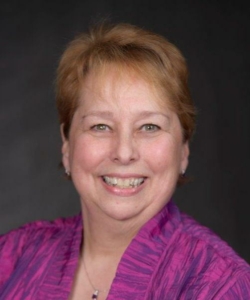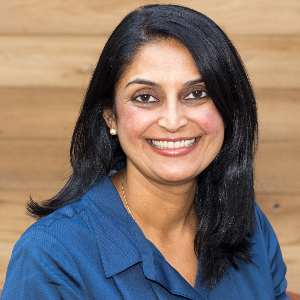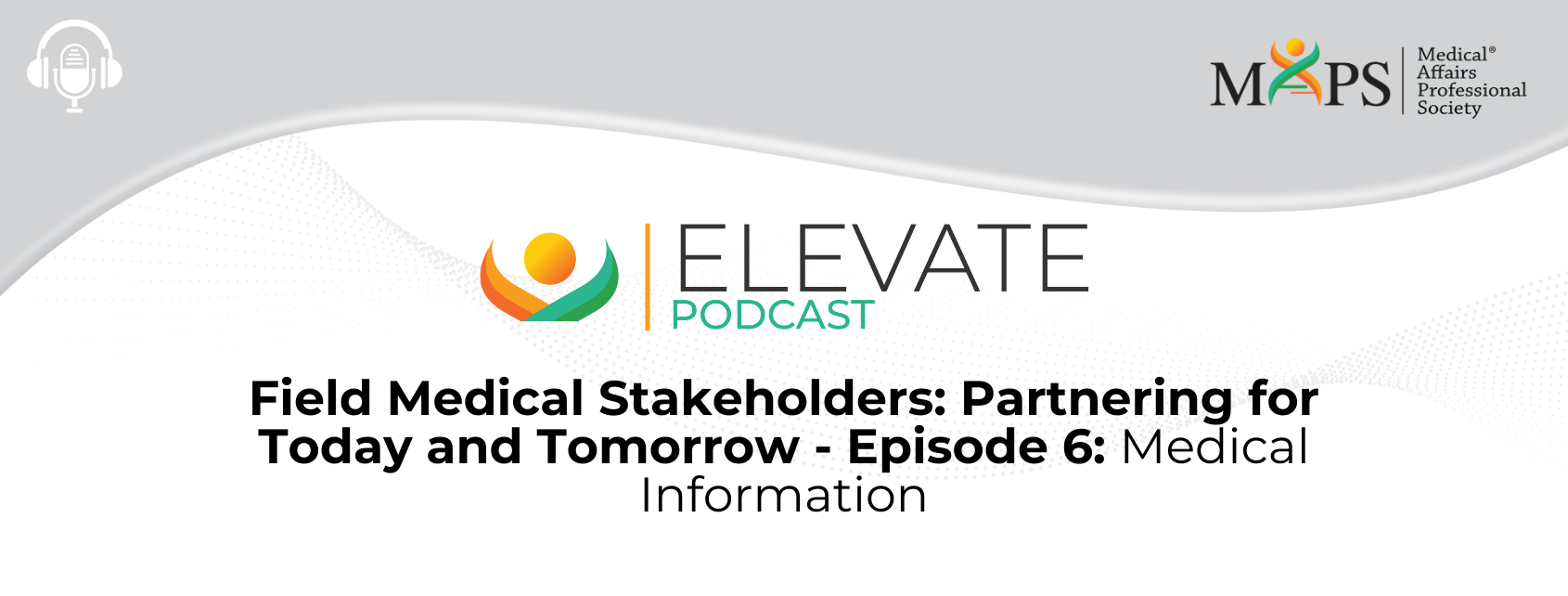Objectives:
At the end of this series of podcasts, the participant should be able to:
· Discuss the functions and activities of key internal partners
· Identify potential areas for compliant collaboration by MSLs with key internal partners

MODERATOR: Kathryn Gann

INTERVIEWER: Urvashi Vashee

SPEAKER: Stacey Fung, PharmD
Following is an automated transcription provided by otter.ai. Please excuse inaccuracies.
Kathryn Gann
Welcome to the Medical Affairs Professional Society Field Medical Focus Area Working Group’s podcast series entitled “Field Medical Stakeholders Partnering for Today and Tomorrow.” In this sixth podcast, we will discuss medical information. I’m Kathryn Gann and I’ll be the moderator for this podcast. I serve as a member of the Field Medical Focus Area Working Group. I’m currently an independent consultant in Medical Affairs, having spent my 30 year career as an MSL and MSL manager and an MSL trainer. First, our legal disclaimer. The views expressed in this recording are those of the individuals I do not necessarily reflect on the opinions of maps, or the companies with which they are affiliated. This presentation is for informational purposes only, and is not intended as legal or regulatory advice. We encourage you to engage in conversations about partnering with field medical stakeholders with other maps members by the community portal on the maps website. Simply log in with the email address and password associated with your maps account and click on the discussion tab. Then scroll down to field medical to post a question or review previous postings. The objectives for this series of podcasts are that at the end of this series, the participant will be able to one discuss the functions and activities of key internal stakeholders and to identify potential areas for compliant collaboration by MSL with key internal stakeholders. I’d like to thank today’s panelists for sharing their subject matter expertise with the maps membership. speaking today are Urvashi Vashee, Executive Director U.S. global medical information interim medical training at Oncopeptides. She will be our interviewer, and Stacy Fung, senior director global medical information at Gilead Sciences, Stacy will be our interviewee. And both of them are members of the Medical Information focus area Working Group, which is another Working Group at maps. Urvashi, could you please briefly just provide information about your current position? how long you’ve been in the industry? What you do, and then I’ll let you take it away and talk to Stacy.
Urvashi Vashee
Great. Thanks so much, Kathy. Yeah, so currently, as Kathy mentioned, I’m working as a US global medical information Executive Director at Oncopeptides. I have been in the industry for about 19 years now in a variety of roles primarily within Medical Affairs. These include medical information, and actually also work as an MSL in my previous my previous life. Stacy, would you be able to please provide a brief background of your history as well before we get started?
Stacey Fung
Of course. So I’ve been in the industry for about 20 plus years, primarily in medical information and medical communications. And prior to joining industry, I worked as a practicing pharmacist. And as you mentioned, I currently am at Gilead Sciences in the medical information department.
Urvashi Vashee
Great. Thanks so much, Stacy. So let’s get started with explaining to all of our colleagues, what is it that medical information does? Could you provide us with a brief background? The medical information function responds to unsolicited questions on companies, products and customers, including healthcare professionals, patients and payers. We provide surveillance clinical and scientific responses, both verbally and in writing. medical information responses typically include a comprehensive and up to date summary of published literature, including off label content.
Stacey Fung
So at Gilead Sciences, the global medical information function sits in the scientific information organization, which is actually in the global Medical Affairs group. So we partner with our global and local Medical Affairs, therapeutic teams, MSL teams, publication team, learning and development groups, our commercial sales training group, as well as pharmacovigilance, and the patient engagement group.
Urvashi Vashee
And so for your specific role, what is that role within your global medical information team affiliates.
Stacey Fung
I am the lead of the global medical information therapeutic area team, which is responsible for creating content and strategy for their affiliate medical information groups across the world. Now, is there a similar us group in your company? And if so, what are the differences between the two groups and how do you both work together? That’s a great question. The US medical information team supports the US Medical Affairs team and partners with the US MSL, commercial marketing and sales with additional activities including oversight of the US contact center and website. Both groups are responsible for sharing customer insights locally or globally with internal partners in support of medical strategies. The remit of the global med info therapeutic area team is to develop medical information content that is Globally relevant for affiliates to use, thus ensuring consistent and compliant responses across all gilliat medical teams. The global med infotech team works closely with the affiliate medinfo groups to ensure any medical content meets the external customers needs in their country. In addition, global tactics, processes and strategies are supported for affiliates to leverage and localize as needed. The global medical team is focused on meeting global needs while working with each affiliate. This partnership requires routine and open communications.
Urvashi Vashee
Now, you mentioned the call center is that call center internal to the organization or is that an external call center?
Stacey Fung
So that’s a great question. So ideally add we have a hybrid model in some regions and external contact center handles all the frontline inquiries from customers and in other regions and external contact center handles overflows and after our support when an internal team is not available.
Urvashi Vashee
And so Stacey, what is your understanding of the role of the MSL?
Stacey Fung
I personally believe in MSL has a number of key focus areas that include addressing customer product information questions, supporting customer research proposals, and sharing customer insights internally the shape medical strategies and these are done by building relationships with customers in the field.
Urvashi Vashee
So having said that, how can the field medical teams interact with your department or similar department? Do you have any best practices to share and partnering with the MSL team?
Stacey Fung
Oh yes, medical information and MSL are sibling organizations. So both are customer focused, and provide information to address customer questions. It is pretty common for each of us, each of the groups to refer customers to each other for follow up. So msls were asked that med info share responses and med info will ask MSL to follow up with customers needing more discussion or interest in research. In my experience, a best practice of partnering is the development of an actionable shared customer insight report, with both met info and MSL customer insights, highlighting similarities as well as differences leading to potential actions. Another best practice includes a partnership on sharing training materials or training sessions. I have also partnered with MSL teams in support of scientific competency briefs and supporting the Medical Affairs conference exhibit booth. I must have also reviewed the med info response documents and FAQ to provide additional perspective on customer needs. Med info teams often share updates on response documents, the latest publications with MSL teams.
Urvashi Vashee
So I know all medical information can function a little bit differently, but what tools does your metaphor team develop? And does your team participate in the promotional review process?
Stacey Fung
That’s a really interesting question. The Galea admin info team develops response documents and FAQ, which the MSL teams often use, but we currently do not participate in promotion review. But in prior roles, my team participated in promotional and medical review of materials that supported sales and medical field teams. So actually, I wanted to ask you a Rishi. We learned that you actually had prior roles as an MSL, and now you’re in med info. Can you tell us a little bit about your career path? And how you actually ended up in medical information? And what has your experience has been working in both areas?
Urvashi Vashee
Yeah, absolutely. I’d be happy to. So as you mentioned, Stacey, I looked at them as sibling walls, if you will, I do think we both need each other to be successful in our roles. And I do think it’s critical for the MSL team to know the resources that the metaphor can can provide, or they can actually find being at the headquarter location. There’s so much wealth and knowledge within the meta butene that people may not know about, if you have not worked in that capacity, or not been in headquarters, I feel like I have had the best of both worlds because I’ve been able to function in both worlds. And I think, you know, both roles have been tremendous for my continuous growth and my learning. And I really enjoyed the field medical wall. And I don’t rule out the possibility of doing something like that in my feature. It just brings a different perspective from the external environment where it’s being in medinfo, you get a very strong internal perspective from our internal stakeholders.
Kathryn Gann
Well, thank you, Urvashi. And Stacy. I love the fact that you were both talking about medinfo and MSL as being sibling organizations, and how the two groups can work together because I can say over my 30 year career, I wouldn’t have gotten as far as I did, if it hadn’t been for the medinfo groups that I knew I could always rely on to give me updated and approved ways of addressing questions and they relied on us certainly as MSL to Tell them what was going on out in the field if I needed to make a new mid letter, so I really appreciate the sibling organization idea hadn’t heard it said that way before, but I’ll use it in future podcasts I’m sure. So I hopefully our audience now has a better understanding of the role and function of medical information, and also how other cells may compliantly interact with this team. This has been the sixth podcast in our series on the topic of field medical stakeholders Partnering for today and tomorrow. If you’re a maps member, thank you for supporting maps. If you’re not yet a maps member, and would like access to additional resources in this area, please visit the maps website to explore joining today at Medical Affairs.org forward slash memberships This concludes the podcast



